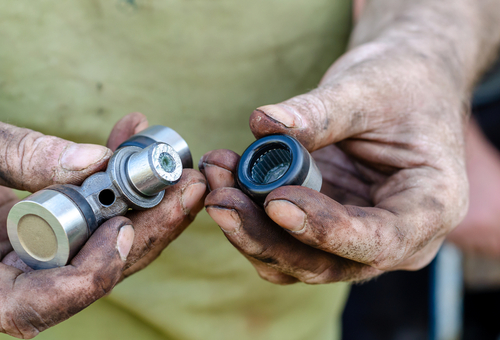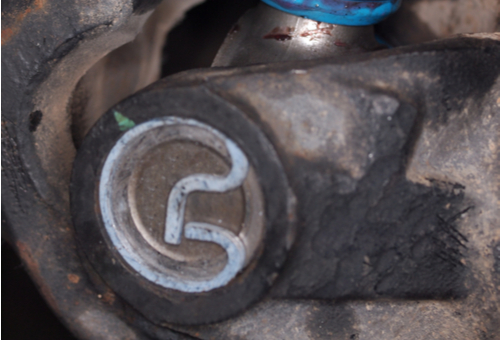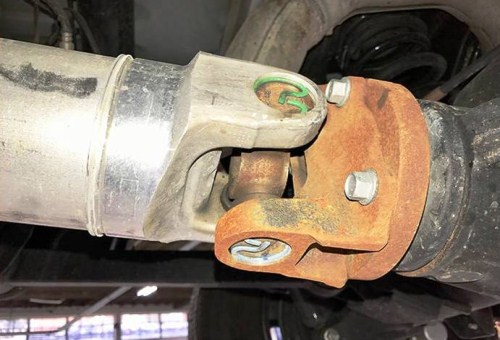
We have all replaced hundreds of universal joints in our careers, but despite our great efforts to always do the job right, it sometimes happens that a customer complains of a vibration that is still present on his vehicle, or of a vibration that has gotten worse after a universal joint replacement. Have you ever wondered why this happens, especially since you always use universal joints of a trusted aftermarket brand? In this article, we will take a closer look at universal joints, and why replacing a worn or damaged universal joint does not always resolve driveshaft-related vibrations, starting with this question-
Since universal joints do not have fixed service or replacement intervals, we usually only become aware of universal joint issues when one fails catastrophically, or when a customer complains of weird mechanical noises and/or odd vibrations that can range from mild, to so severe that the vehicle becomes inoperable. The problem is however that since universal joints can fail in several ways and for a wide variety of reasons, simply replacing a failed universal joint may not resolve the issue, so let us look at some common universal joint failure modes, starting with-
Brinelling
This looks like the needle rollers had been pressed into the trunnion surface, which leaves indentations in the trunnion surface as a result of the needle rollers being unable to roll or rotate between the trunnion and the bearing cup. There are several possible causes of brinelling, including one or more of the following-
Spalling
This looks like some parts of the surface on one or more trunnions had been scraped off, which is most commonly caused by the ingress of water and solid contaminants into the space between the needle rollers and the trunnion surface.
Burnt trunnions
This is almost always caused by improper lubrication as the result of one or more of the following-
Galling of trunnion ends
This looks like material had been gouged out of one or more trunnion ends, which is usually caused by excessive operating angles.
Universal joint fractures
While it is relatively rare for universal joints to fracture or break, it can happen as the result of severe or repeated shock loads. If universal joints on a vehicle break repeatedly, and especially on a heavily modified vehicle, check the drive shaft installation to verify that the driveshaft is not too small, or underrated for the current application.
Improper installation
Improper installation procedures arguably cause more universal joint failures than any other cause, with the possible exception of installing substandard aftermarket universal joints.
For instance, hammering bearing cups into yoke ears almost always drives bearing cups into yoke ears at an angle to the yoke bore, but because hammer blows mask the resistance of an out-of-true bearing cup, the problem often goes unnoticed. Out-of-true bearing cups do not only place huge demands on the needle rollers but since the needle rollers are often prevented from rotating, effective lubrication is almost impossible to achieve, as well.
The best way to fit bearing cups is to press them home with a tool such as a suitably modified G-clamp because the increased resistance from an out-of-true bearing cup can be felt immediately- which allows you to take corrective action before the universal joint suffers fatal damage.
TIP: It can sometimes be difficult to detect yoke ear bores that are not aligned with respect to each other, but there is one foolproof way around this. Have a machine shop make you a go-no-go gauge (pin) that passes through both yoke ears on an axis. This pin should however not be more than 0.01mm smaller than the bearing cups’ outside diameter; if the yoke ears are aligned, the gauge will pass through both without resistance. Conversely, if the yoke ears are misaligned, the gauge will not pass through the opposite ear. The downside is that this tool will cost you money, and you would need several to suit all the popular universal joints sizes, but having a set of yoke gauges will largely prevent comebacks due to universal joints failing prematurely because you could not see or detect misaligned yoke bores.
Operating angles are not cancelled out
While many multi-part driveshafts have master splines in slip joints to prevent misalignment of the parts, many do not. In practice, this means that on drive shafts without master splines it is sometimes easy to misalign one part of the driveshaft with respect to the other(s), which means that the resulting severe torsional vibrations could destroy not only misaligned universal joints, but input shaft bearings in differentials and output shaft bushes in gearboxes as well.
The above are necessarily brief descriptions of most of the common universal joint failure modes. Assuming then that all underlying issues and problems with the driveshaft have been corrected, you are now ready to replace one or more universal joints on your customer's vehicle, but the question now becomes this-

The image above shows something that we do not see often in aftermarket universal joints, which is coloured circlips like the one shown here. If you are new to universal joints and their replacement, you should know that coloured circlips are a feature of most OEM universal joints; not because they are pretty, but because each colour denotes a different thickness. Circlips of different thicknesses are roughly analogous to the shims used in some engines to adjust valve clearances, but why do you need to adjust universal joints, you may ask?
You may well ask, but before we get to specifics, consider this excerpt from an original patent application filed in the late 1960s by a major American universal joint manufacturer. The application was titled “Retaining ring and groove assembly for a universal joint”, and it was assigned the number US3369378A when it was awarded-
“Another common cause of failure to properly position the members* results from dishing of the ring member in a conical manner and the presence of excessive tolerances thus allowing relative movement of the members to take place. When the ring member dishes, the groove wall will have a greater tendency to flare out conically since the groove wall becomes loaded at its outer edge portion.” (Italics added)
* Note that the word “members” is US patent-speak for some, or all of the parts that make up the whole, which in this case, are the bearing cups and the retaining circlips of a universal joint.
This particular patent expired in 1985, but the point is that the applicant was the world-leading manufacturer of high-quality universal joints. Nonetheless, this manufacturer recognized that despite all efforts to ensure or achieve dimensional uniformity in all their products, mass production methods made it impossible to produce millions of universal joints and drive shaft yokes that were all exactly the same size.
Therefore, and as a practical matter, the patent application revolved around the description of a), the design of circlips that had the greatest possible contact area between its groove and the outer face of the bearing cup to prevent excessive wear of the circlip groove, and b), the use of circlips of different thicknesses. The idea behind different circlip thicknesses was to compensate for manufacturing tolerances in universal joints to make it possible to centre a universal joint exactly between two sets of yoke ears.
While all of the above may be interesting to some readers, it must be noted that the importance of centring a universal joint between the yoke ears cannot be overstated. The reason for this is that an un-centred universal joint causes the rotational plane of a drive shaft to orbit around the centre of the driveshaft assembly, instead of the driveshaft rotating around its own centre. This not only causes vibrational issues due to excessive run-out, but it also places unbalanced loads on universal joints, which is among the leading causes of universal joint failures.
So, to answer the question at the top of this section: if you have corrected all the underlying issues that caused the original universal joint to fail and you are installing a high-quality replacement according to industry standards, it is unlikely that the replacement will fail prematurely but things are not always as clear-cut, because-
We can put this sub-heading in another way by saying that since car manufacturers do not produce universal joints, the same universal joints that are produced by parts manufacturers for OEM-fitment are also available in the aftermarket. These are sold under many different brand names, some or all of which may be familiar to you.
However, since we cannot promote one brand of superior universal joints over another, so can we not single out the bad ones so instead of naming names, we will look at the characteristics of universal joints to determine what makes a good universal joint, and what makes a bad universal joint. Let us start with-
Price
As with most other kinds of replacement parts, there is a direct correlation between the price and quality of universal joints. For instance, do you believe parts salespersons when they tell you that the $25 universal joint they have on special offer this week is made to the same standards as a $140 OEM-equivalent universal joint? If that were true, nobody would ever pay $140 for a universal joint.
Dimensions
There are no non-critical dimensions on an OEM-equivalent universal joint, but having said that, the most important dimension to check is the cross span, which is the distance between the outer surfaces of the bearing cups on both axes. This dimension is always published in service information, and while it is rare to find a universal joint that matches published dimensions exactly, the dimensions of high-quality universal joints will fall within allowable tolerances.
This is critically important since the variously coloured circlips that come with OEM-equivalent universal joints are meant to compensate for allowable tolerances. Bear in mind that while the endplay on a fitted universal joint must never be zero, the different circlips will allow you to a), install the universal joint in such a manner that the prescribed free play always falls within allowable tolerances, and b), to centre the universal joint exactly between the four yoke ears. Establishing the correct endplay and position within the yoke(s) may mean fitting circlips of two different thicknesses, but in these cases, the different circlips will always be on two different axes, as shown below.

By way of contrast, substandard universal joints will always come with just one set of circlips, and in all the cases this writer has ever encountered, the accompanying circlips were always substantially thinner than the width of the circlip grooves, presumably, to make installation easier. Thus, when this difference is added to the deviation of the cross span dimension from published dimensions, it is possible to see endplay distances of up to 1 mm, which is several times more than the maximum allowable limit on most modern applications. In such a case, severe vibration and premature universal joint failure are givens.
NOTE: To measure endplay, carefully clamp the end flange in a bench vice, and move the assembled driveshaft up and down against a stabilised dial gauge that is centred on a bearing cup. Note that you have to do this in both axes, and while you may require an assistant to make the job easier, it is nevertheless a required procedure if you don’t want to see a comeback.
Lubricant retention
Many, if not most cheap aftermarket universal joints use a simple cup-like rubber seal to seal the bearings and to prevent lubricant from being flung out of the needle rollers under centrifugal force. However, these seal designs date back to the late 1950s and early 1960s and are based on patents that had expired in the 1970s, which means that anybody can now make and sell universal joints that are based on these designs.
The problem with these seals is that while they do a passably good job of retaining lubricants, they are virtually useless at keeping water and solid contaminants out of the needle rollers. Note though that while it is possible to flush contaminated lubricant out of these universal joints via grease nipples, new lubricant does not fix the damage already done by solid contaminants.
OEM-equivalent universal joints on the other hand, use a complex, multi-lip seal that is contained within a steel holder, which both keeps lubricant in and contaminants out. For this reason, most high-quality universal joints that use multi-lip seals come pre-lubricated and therefore do not have grease nipples. In fact, if all other things are equal, it is the effectiveness of multi-lipped seals that makes OEM-equivalent universal joints last (almost) forever.
Thrust washers & spacers
Most OEM-equivalent universal joints are fitted with thrust spacers to prevent metal-to-metal contact between the trunnion ends and the bottoms of the bearing cups. Additionally, most OEM-equivalent universal joints also have Teflon or nylon thrust washers that prevent metal-to-metal contact between the ends of the needle rollers and the bottoms of the trunnions, which greatly reduces friction in the universal joint.
We hope that this article has given you some new insights into both the nature of universal joints and why these components sometimes fail for no apparent reason. Mechanical components always fail for a reason, but with a bit of forethought and knowledge of the most common failure modes, most of the guesswork, and with it, most of the reasons why universal joints fail can be avoided when next you install new universal joints.